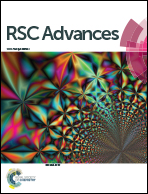Advanced nitrogen removal from the biological secondary effluent of dyeing wastewater via a biological–ferric–carbon nitrification and denitrification process†
Abstract
It is often difficult for the ammonia nitrogen (NH4+-N) concentration in biological secondary effluent of dyeing wastewater to reach the discharge standard by biological treatment due to the nitrogen-containing auxiliary application. Therefore, a biological–ferric–carbon nitrification and denitrification process is applied in this study. In the ferric carbon system, either under the condition of sludge seeding or not, nitrifying bacteria are accumulated to form a biological–ferric–carbon system, in which the nitrification process is initiated. Under the condition of sludge seeding, a higher NH4+-N removal efficiency is reached in a shorter period. In addition, the biological–ferric–carbon system has advantages both in NH4+-N and COD removal because of mutual promotion effects. In the subsequent denitrification process, an extra carbon source is necessary, and the Fe3+ in the nitrification liquid is beneficial for denitrification, thus a denitrification efficiency of nearly 90.2 ± 2.1% is achieved in the short period of 2 h, however, only 44.6 ± 1.5% NO3−-N is denitrified during 6 h when Fe3+ is removed by coagulation. Under optimal operation conditions for the biological–ferric–carbon nitrification and denitrification process, the NH4+-N concentration decreased from 32.3 ± 1.5 mg L−1 to 2.5 ± 0.2 mg L−1, the effluent total nitrogen was less than 8.8 ± 1.0 mg L−1, and COD was reduced from 120.0 ± 6.0 mg L−1 to 49.4 ± 2.1 mg L−1, which presents a good performance both in advanced nitrogen removal and COD degradation.


 Please wait while we load your content...
Please wait while we load your content...